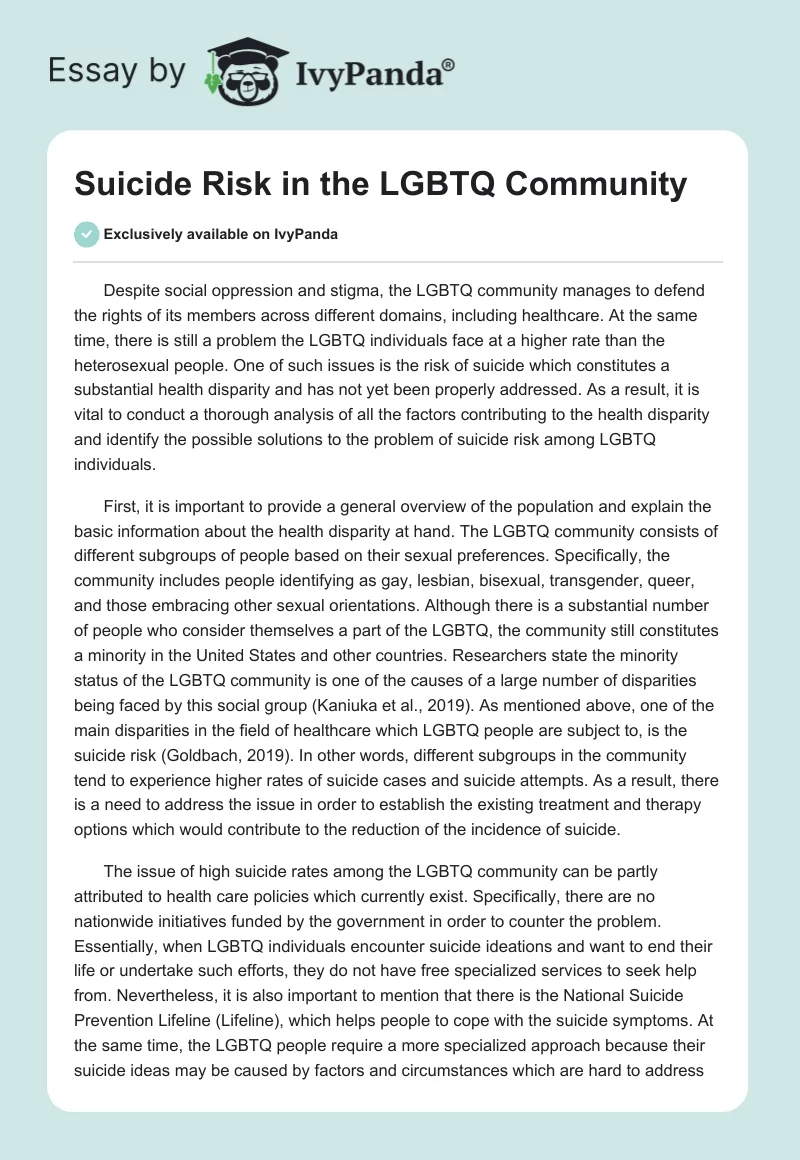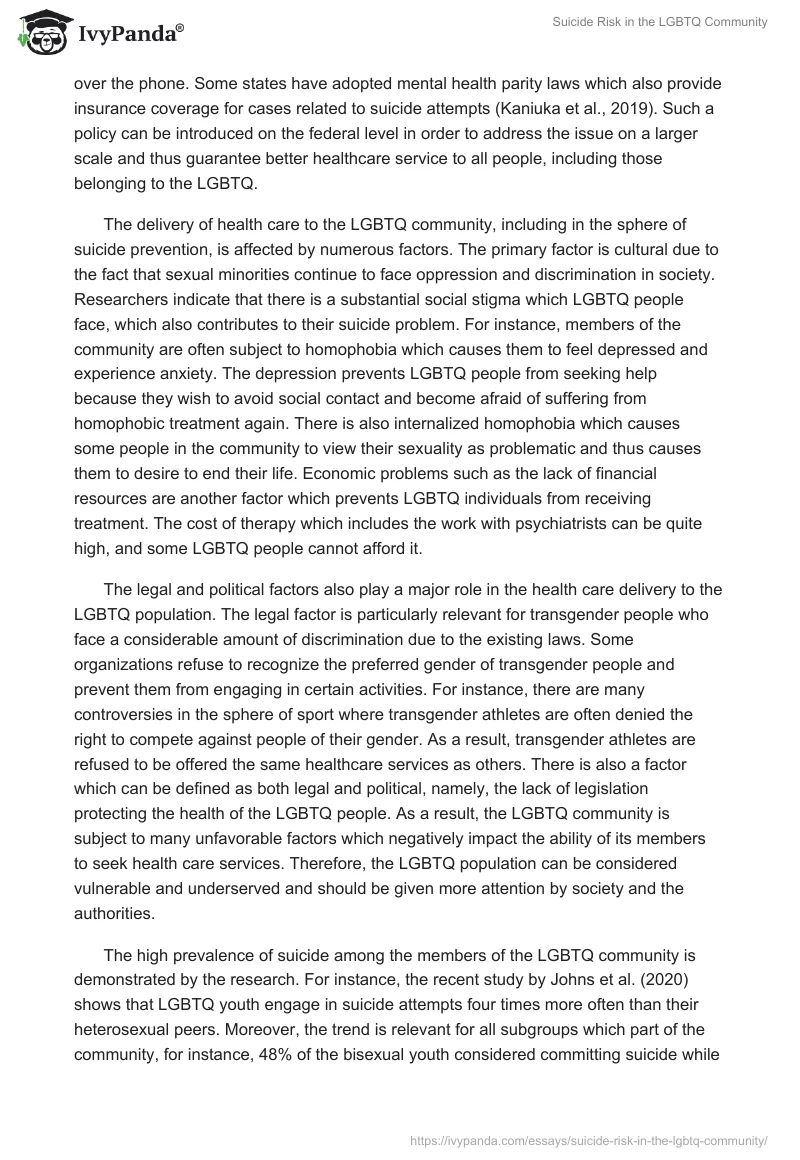Despite social oppression and stigma, the LGBTQ community manages to defend the rights of its members across different domains, including healthcare. At the same time, there is still a problem the LGBTQ individuals face at a higher rate than the heterosexual people. One of such issues is the risk of suicide which constitutes a substantial health disparity and has not yet been properly addressed. As a result, it is vital to conduct a thorough analysis of all the factors contributing to the health disparity and identify the possible solutions to the problem of suicide risk among LGBTQ individuals.
First, it is important to provide a general overview of the population and explain the basic information about the health disparity at hand. The LGBTQ community consists of different subgroups of people based on their sexual preferences. Specifically, the community includes people identifying as gay, lesbian, bisexual, transgender, queer, and those embracing other sexual orientations. Although there is a substantial number of people who consider themselves a part of the LGBTQ, the community still constitutes a minority in the United States and other countries. Researchers state the minority status of the LGBTQ community is one of the causes of a large number of disparities being faced by this social group (Kaniuka et al., 2019). As mentioned above, one of the main disparities in the field of healthcare which LGBTQ people are subject to, is the suicide risk (Goldbach, 2019). In other words, different subgroups in the community tend to experience higher rates of suicide cases and suicide attempts. As a result, there is a need to address the issue in order to establish the existing treatment and therapy options which would contribute to the reduction of the incidence of suicide.
The issue of high suicide rates among the LGBTQ community can be partly attributed to health care policies which currently exist. Specifically, there are no nationwide initiatives funded by the government in order to counter the problem. Essentially, when LGBTQ individuals encounter suicide ideations and want to end their life or undertake such efforts, they do not have free specialized services to seek help from. Nevertheless, it is also important to mention that there is the National Suicide Prevention Lifeline (Lifeline), which helps people to cope with the suicide symptoms. At the same time, the LGBTQ people require a more specialized approach because their suicide ideas may be caused by factors and circumstances which are hard to address over the phone. Some states have adopted mental health parity laws which also provide insurance coverage for cases related to suicide attempts (Kaniuka et al., 2019). Such a policy can be introduced on the federal level in order to address the issue on a larger scale and thus guarantee better healthcare service to all people, including those belonging to the LGBTQ.
The delivery of health care to the LGBTQ community, including in the sphere of suicide prevention, is affected by numerous factors. The primary factor is cultural due to the fact that sexual minorities continue to face oppression and discrimination in society. Researchers indicate that there is a substantial social stigma which LGBTQ people face, which also contributes to their suicide problem. For instance, members of the community are often subject to homophobia which causes them to feel depressed and experience anxiety. The depression prevents LGBTQ people from seeking help because they wish to avoid social contact and become afraid of suffering from homophobic treatment again. There is also internalized homophobia which causes some people in the community to view their sexuality as problematic and thus causes them to desire to end their life. Economic problems such as the lack of financial resources are another factor which prevents LGBTQ individuals from receiving treatment. The cost of therapy which includes the work with psychiatrists can be quite high, and some LGBTQ people cannot afford it.
The legal and political factors also play a major role in the health care delivery to the LGBTQ population. The legal factor is particularly relevant for transgender people who face a considerable amount of discrimination due to the existing laws. Some organizations refuse to recognize the preferred gender of transgender people and prevent them from engaging in certain activities. For instance, there are many controversies in the sphere of sport where transgender athletes are often denied the right to compete against people of their gender. As a result, transgender athletes are refused to be offered the same healthcare services as others. There is also a factor which can be defined as both legal and political, namely, the lack of legislation protecting the health of the LGBTQ people. As a result, the LGBTQ community is subject to many unfavorable factors which negatively impact the ability of its members to seek health care services. Therefore, the LGBTQ population can be considered vulnerable and underserved and should be given more attention by society and the authorities.
The high prevalence of suicide among the members of the LGBTQ community is demonstrated by the research. For instance, the recent study by Johns et al. (2020) shows that LGBTQ youth engage in suicide attempts four times more often than their heterosexual peers. Moreover, the trend is relevant for all subgroups which part of the community, for instance, 48% of the bisexual youth considered committing suicide while 27% actually attempted it (Johns et al., 2020). 37% of gay or lesbian youth considered suicide, while only 14% of their heterosexual peers did the same. Although there is no data on Los Angeles yet, in California, 29.4% of the LGBTQ youth actually attempted suicide which is much more than the 6.4% among the heterosexual students (“Suicide risk,” 2018). The prevalence of suicide instances and suicide attempts is also high among LGBTQ adults who have suicide ideations much more frequently than the rest of the population (“Suicide risk,” 2018). Such data constitutes considerable evidence in support of the idea that the LGBTQ community is subject to a substantial health disparity in the form of suicide risk.
Despite the existing challenges, the LGBTQ people can access certain support groups and other treatment options. At the same time, the majority of the initiatives occur on the local level and are funded by states or provided by charity organizations. For instance, in Los Angeles, there is the Los Angeles LGBT Center which provides a variety of services to the local community. Specifically, people can seek different types of therapy, including individual, couples, family, and group, as well as psychiatric care at the center (“Mental health,” n.d.). The support is provided across different domains, including suicide prevention which involves helping people with addressing their ideations and attempts. The services provided by the Los Angeles LGBT Center are easy to access and do not require any payments since they are offered for free. The programs delivered by the center also do not imply having any stigma because the people undergoing them do not face any discrimination and oppression. Essentially, the center serves as a safe space for LGBTQ people who require support and assistance when dealing with suicidal thoughts and other problems.
Nevertheless, the center does not provide comprehensive care, and there are nursing interventions which can be even more effective. For instance, one of the main approaches to addressing the problem of suicide in vulnerable populations such as the LGBTQ people is the use of the Caring Contacts program. Such an intervention involves sending messages of support and connection to suicidal individuals over the course of one year, and it has demonstrated positive results in the reduction of suicide incidence (Reger et al., 2017). The intervention can be easily taught to nursing specialists as well as other healthcare professionals. At the same time, such an approach requires interprofessional team building in order to support suicidal LGBTQ patients. One of the key elements which can strengthen the effectiveness of interventions and interprofessional teamwork is the cultural competence of the medical staff. For instance, all healthcare providers must be aware of the fact that LGBTQ people experience a health disparity concerning suicide (Margolies & Brown, 2019). Therefore, it is important that healthcare professionals are able to identify their LGBTQ patients’ concerns early by employing their cultural competence.
Although Los Angeles is the place where the LGBTQ people have access to various therapy programs, additional suicide-prevention interventions should be launched. First of all, it is essential to address the core factors contributing to suicides, such as social stigma. The healthcare providers must be open about their willingness to support LGBTQ people and deliver services to them, for instance, by displaying the rainbow pride flag (Zullo et al., 2021). Another important initiative which should be adopted in Los Angeles is the cultural training of the healthcare workers. Another effective intervention for the reduction of suicides is the offering of emotional support to LGBTQ youth and the protection of their confidentiality (Zullo et al., 2021). Essentially, younger people often are afraid of facing social stigma related to their sexual orientation. Studies show that the high level of privacy guaranteed to LGBTQ patients by healthcare workers can make them more willing to seek help in relation to suicide ideations and attempts (Zullo et al., 2021). Thus, such interventions should be adopted in Los Angeles to address the health disparity in terms of suicide risk faced by the LGBTQ community.
The problem of suicide is an actual health disparity which the LGBTQ community is subject to in the United States. The statistics show that people who identify as members of the LGBTQ community are more likely to have suicide attempts than heterosexual individuals. Moreover, suicide prevalence is particularly high among LGBTQ youth, who tend to engage in suicide-related activities more often than their peers. The primary factors contributing to the health disparity are the social stigma suffered by the LGBTQ people and the lack of government funding for suicide prevention projects. At the same time, in certain communities such as Los Angeles, LGBTQ individuals have access to free therapy. In order to address the suicide health disparity in the LGBTQ community, the local governments, including Los Angeles, need to adopt policies promoting support for the LGBTQ people among healthcare providers.
References
Goldbach, J., Rhoades, H., Green, D., Fulginiti, A., &, Marshal, M. (2018). Is there a need for LGBT-specific suicide crisis services? Crisis, 40(3), 1–12.
Johns, M. M., Lowry, R., Haderxhanaj, L. T., et al. (2020). Trends in violence victimization and suicide risk by sexual identity among high school students — Youth Risk Behavior Survey, United States, 2015–2019. Morbidity and Mortality Weekly Report, 69(1), 19–27.
Kaniuka, A., Pugh, K. C., Jordan, M., Brooks, B., Dodd, J., Mann, A. K., Williams, S., &, Hirsch, J. K. (2019). Stigma and suicide risk among the LGBTQ population: Are anxiety and depression to blame and can connectedness to the LGBTQ community help? Journal of Gay & Lesbian Mental Health, 23(2), 1–16.
Margolies, L., & Brown, C. G. (2019). Increasing cultural competence with LGBTQ patients. Nursing, 49(6), 34–40.
Mental health. (n.d.). Los Angeles LGBT Center. Web.
Reger, M. A., Luxton, D. D., Tucker, R. P., Comtois, K. A., Keen, A. D., Landes, S. J., Matarazzo, B. B., & Thompson, C. (2017). Implementation methods for the caring contacts suicide prevention intervention. Professional Psychology: Research and Practice, 48(5), 369–377.
Suicide risk and prevention for LGBTQ people. (2018). National LGBT Health Education Center. Web.
Zullo, L., van Dyk, I., Ollen, E., Ramos, E., Asarnow, J., &, Miranda, J. (2021) Treatment recommendations and barriers to care for suicidal LGBTQ youth: A quality improvement study, evidence-based practice. Child and Adolescent Mental Health, 6(3), 393–409.


